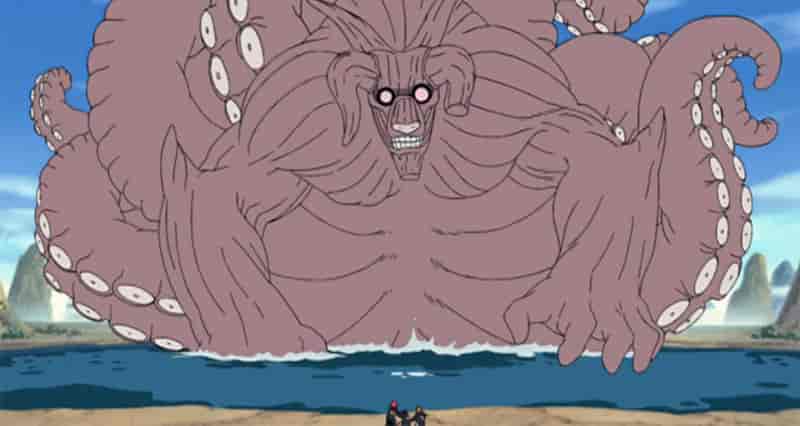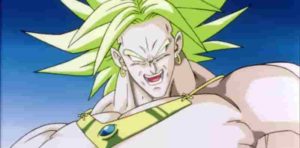Mythology references in Naruto include:
- Naruto—The Nine Tailed Fox
- Sasuke— Susanoo the Storm God
- Sharingan—Shinto Creation Myth
- Jiraiya, Orochimaru & Tsunade— The Tale of the Gallant Jiraiya
- Mythic Beasts: Bijuu and Isonade
Naruto is an enormous franchise that pulls an immense amount of cultural creativity from Japanese, Buddhist and other Eastern lore. In many ways, the expansive series is a clash of ideology between classic Japanese and Shinto worldviews with Buddhist worldviews. However, the reverence of all these cultures is captured in the story, style and themes of this manga/anime.
Ideas like chakras, the five elements of creation give us a basis for the world of shinobi Naruto inhabits. However, as we explore the surrounding world, we travel through elements of long and rich Eastern mythologies.
Naruto—The Nine Tailed Fox
The cyclone-inspired hero of the story, Naruto embodies a human coming to terms with his inner darkness—the nine tailed fox, Kitsune.
These trickster spirits range from devious to outright evil. However, their Chinese origin can give them godlike status at times. Most commonly, the fox spirit is known to grow in magic and wisdom as it ages, sprouting new tails as it goes. These fox spirits are said to transform into beautiful women—either to trick doomed men into their demise or as goddesses or celestial beings.
Hilariosly, Naruto taps into this trickster motif. However, his nine tailed fox is a bit more on the evil side—a giant creature of absolute fiery destruction. His path leads him to master this inner evil, turning Kitsune into an ally and using his power for good.
Sasuke—Susanoo the Storm God
Sasuke—a stereotypical ninja name in Japan—is thematic of several ideas. Obviously, he is the main character that wields the legendary Sharingan. However, there is a strong connection to an important character in Shinto mythology, Susanoo the Storm God.
Famously, Susanoo feuded with his family. Eventually, he was cast out of heaven for his feuding. He had a real dark side and was honestly a bad dude. However, as an outcast, he would find redemption for his dark ways by slaying a massive, multiheaded snake named Yamata no Orochi. Sound familiar?
Obviously, Sasuke comes into his ultimate Susanoo power, making the connection direct. However, he built up to this thematic form throughout the series. One of his earliest major achievements was to learn Kakashi’s lightning blade (Chidori attack). Susanoo relates to the storm and sea, making this unique attack spark my interest in Sasuke’s connection with Susanoo. As a bonus, Sasuke develops his own ultimate lightning technique named Kirin. Kirin is legendary chimera with a dragon’s body, deer horns and hooves and a lion’s tail.
Though Orichimaru is connected to another tale I will talk about, his snake connection to Yamata no Orochi seems like a cross reference. He was focused on capturing Sasuke throughout the original Naruto, and eventually was slain by Sasuke.
Sharingan—Shinto Creation Myth
The Uchiha’s Sharingan power, as well as other “ocular jutsu” from the Naruto world, is a reference to Shinto god, Izanagi. This especially comes to light in the ninja war saga of Naruto Shippuden.
Izanagi has a tragic story. First, he lost his wife. Then, he attempted to brave the underworld and bring her back, only to come up empty handed. As he returned to the land of the living, he undertook a washing ritual, cleansing his face of what he saw. This cleansing birthed more kami, including 3 famous kami—one from each of his eyes and one from his nose.
From Izanagi’s eyes came the sun and moon kami, Amaterasu and Tsukuyomi. Then, his nose birthed Susanoo, the kami of storms and the sea. As the villainous, Sharingan-using Madara brings the ninja war to an apex, he is calling on the forces of creation to hypnotize the world. In fact, the technique is called “Infinite Tsukuyomi”, referring to the moon goddess. He’s already breaking the laws of life and death to wage war on the world—why not grasp the power of creation itself.
Jiraiya, Orochimaru & Tsunade— The Tale of the Gallant Jiraiya
The three mighty Sanin of the Leaf Village throw down in the early seasons of Naruto, each reflecting the three main characters of a Japanese classic, The Tale of the Gallant Jiraiya.
Unlike the lovable sage master from Naruto, the original Jiraiya wasn’t a great guy. In fact, he was the kind of guy to strike down unarmed women with his gang of bandits. However, this titular character is set on a course of heroism by an old sage who teaches him toad magic. He sets off into the world a changed man, stealing from the rich and giving to the poor.
One day, he meets a beautiful woman, Tsunade, who has mastered slug magic. She was trained by the same old sage, who made sure she met Jiraiya. Together, this couple would face off against the sinister Orochimaru, a warlord possessed by a snake demon.
Though Jiraiya was a talented swordsman, his toad magic was weak against Orochimaru’s evil snake magic. However, Tsunade’s slug magic beat Orochimaru’s snake magic.
Ultimately, Jiraiya and Tsunade made a daring quest to retrieve Nakimaru (wave-cutting sword) and exercise the snake demon from Orochimaru. Free of evil, he would return to being a normal man.
Mythic Beasts: Bijuu and Isonade
Many mythical beasts from Japan and China are referenced in Naruto, filling the world with so much flavor. In fact, the story includes creatures from all sorts of Eastern references. Here, I will focus on the beasts with the strongest mythological ties.
- Shukaku: The one tailed beast that resides in Gaara resembles the fabled tanuki—a shapeshifting yokai that looks like a racoon dog. The tanuki of folklore are mischievous and absent minded—not quite the angry terror we see in Shukaku.
- Matatabi: The cat-like 2 tails takes reference from the terrifying kasha—a fiery cat yokai that raids funerals. Like foxes, Japanese folklore suggests cats can grow multiple tails and gain magic as they age. Naturally, cats get a reputation for being somewhat evil—go figure.
- Son Goku: Of course, we can’t forget the legendary monkey king, made famous by the Buddhist-inspired adventure, Journey to the West. The 4 tails pays homage to this legendary character. Plus, the 3rd Hakoge’s summon, Enma, referenced him as well. This ape summon could transform into a giant, indestructible fighting pole. This growing pole relates to the monkey king’s famous weapon.
- Gyuki: Killer Bee’s 8 tails takes the form of a giant, bull-headed octopus. Otherwise known as Ushioni, this horned monster is said to devour sailors off the coast of Japan.
- Isonade: This barbed shark monster is referenced in two different characters (one a water style ninjutsu expert). However, this legend has a close resemblance to Kisame and his living sword, Samehada. First, Kisame has a shark-like appearance. However, Samehada has the barbs. Both of which are fond of carnage.
To Sum it Up
Related Posts:
Dragon Ball Z: Why Does Broly Hate Goku?
| Ghost in the Shell: What is a Ghost?
|
Naruto holds an enormous amount of cultural, religious and philosophical content from East Asia. Spanning from India to Japan, the creators of this epic anime drew from a deep creative well. Perhaps that is why Naruto stands out among its peers in the anime world. This visually striking design is unique, and exploring the stories behind the aesthetic has been fascinating.




